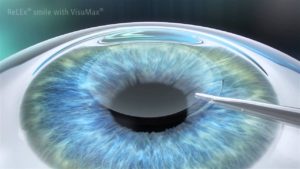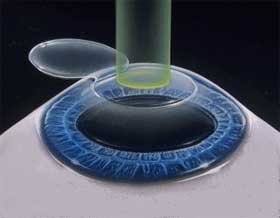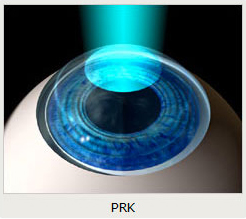SMILE, LASIK, and PRK:
SMILE, LASIK, and PRK are forms of laser vision correction that reshape the cornea, the main focusing structure of the eye. While each of these versions of laser eye surgery uses a laser, they are different in how they go about their goal of improving vision.
SMILE
In SMILE (Small Incision Lenticular Extraction), an ultra-short pulse laser called a femtosecond laser is used to sculpt a lenticle inside the cornea, beneath the corneal surface. A small “side cut” incision is made at the cornea surface and the lenticle is removed. Once the lenticle is removed, the surface of the cornea sinks down to a new shape, changing the shape of the cornea and changing its focus.
LASIK
LASIK uses a different type of laser than SMILE does, employing an excimer laser to reshape the cornea. When LASIK is performed, a surface flap is created and then the underlying cornea is reshaped using the excimer laser. The flap is reposistioned and heals into place, adopting the shape created by the excimer laser.
PRK
PRK, also known as “flapless LASIK”, applies the excimer laser to the surface of the cornea but no flap or lenticle is made.
Pros and Cons of SMILE vs LASIK
Both SMILE and LASIK offer very quick recovery and excellent results, however there are significant differences. While both SMILE and LASIK can treat nearsightedness and astigmatism, SMILE is not yet able to treat farsightedness, although hopefully it will be able to do so in the future. LASIK has a significant advantage in that the laser can be programmed with customized wavefront technology, the NASA- derived tech that allows the laser to customize the treatment to the individual optical characteristics of each person’s eye. The laser in SMILE, by contrast, can only be programmed to treat using a technology similar to what is used to create glasses or contact lenses — a non-custom approach based on the “which is better one or two test” known as “conventional” technology. In this regard, LASIK is able to offer more precise treatments.
Visual Acuity: SMILE vs Customized Wavefront LASIK
A new study looked at the results of SMILE compared to customized wavefront LASIK (the most evolved format of LASIK) and found that visual acuity outcomes were superior in the LASIK group compared to the SMILE group. This confirms previous studies that I have blogged about showing superior results with customized wavefront LASIK compared to SMILE.
Corneal Strength and Biomechanics: SMILE vs Customized Wavefront LASIK
One theoretical advantage that has been proposed for SMILE is that it has less biomechanical weakening effect on the cornea than LASIK does. Because the side cut is so much smaller than the flap, some surgeons have thought that LASIK actually weakens the cornea more than SMILE does. However, a new study showed that while the side cut does produce less biomechanical weakening than the flap before the lenticle is removed, once the lenticle is removed from the cornea and healing is allowed to occur, the biomechanical weakening effect of SMILE and LASIK is nearly identical.
Customized Wavefront PRK vs SMILE and Customized Wavefront LASIK
Overall, studies suggest that it is PRK that has the least biomechanical weakening of the laser vision correction procedures, offering far less weakening than either SMILE or LASIK. This is because with PRK there is neither a side cut or a flap. In PRK, the laser is simply aplied to the surface of the cornea to reshape it. PRK, like LASIK, has the advantage that it can employ customized wavefront technology so it has the same excellenet vision results as customized wavefront LASIK. The disadvantage to PRK is that it has longer recovery time than either SMILE or LASIK.
Conclusion: SMILE vs Customized Wavefront LASIK and PRK
While both SMILE and Customized Wavefront LASIK/PRK offer excellent tools for correcting vision, at this point the advantage in my opinion goes to customized wavefront LASIK and PRK over SMILE. The main reason for this is LASIK and PRK’s ability to use the enormous benefits of customized wavefront technology, something SMILE is unable to do at this time. Customized wavefront technology simply allows for more accurate, more customized treatments with better results. In corneas that would benefit from the least weakening, I feel customized wavefront PRK offerst the best approach. I think SMILE is a promising technology, but it is early in its development and evolution.



